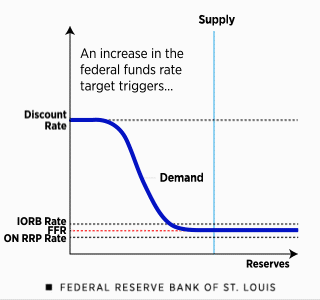Expansionary and Contractionary Monetary Policy
Now that you know about the Federal Reserve’s policy tools, let’s see how the Fed uses the tools to achieve its dual mandate—maximum employment and price stability.
How Expansionary Monetary Policy Works
Suppose the economy weakens and employment falls short of the Federal Reserve’s maximum employment goal. Meanwhile, the inflation rate is showing signs that it will fall below the target. The Federal Open Market Committee (FOMC) might decide to use expansionary monetary policy to provide stimulus for the economy. That is, the FOMC could lower its target range for the federal funds rate (FFR).
When doing so, the Fed would decrease its administered interest rates—interest on reserve balances (IORB), overnight reverse repurchase agreement (ON RRP) offering, and discount—accordingly.
Expansionary Monetary Policy Graph
This animated graph of expansionary monetary policy shows how a cut in the federal funds rate target triggers a decrease in the Fed’s administered rates, which results in a lower federal funds rate.
These actions by the Fed would transmit to other market interest rates and broader financial conditions. Here is how expansionary monetary policy translates into the economy:
- Lower interest rates decrease the cost of borrowing money, which encourages consumers to increase spending on goods and services and businesses to invest in new equipment.
- The increase in consumption spending by consumers and investment spending by businesses increases the overall demand for goods and services in the economy.
- With increased production, businesses are likely to hire additional employees and spend more on other resources.
- As these increases in spending ripple through the economy, unemployment decreases, moving the economy toward maximum employment.
So, the Fed’s monetary policy tools can be effective for moving the economy back toward the maximum employment component of the dual mandate when the economy is weak.
How Contractionary Monetary Policy Works
Suppose that inflation has exceeded 2 percent for some time and the Federal Reserve recognizes that individuals are starting to expect high and rising inflation going forward. In this situation, the Federal Open Market Committee (FOMC) might decide to use contractionary monetary policy to bring actual and expected inflation back toward its target, to maintain price stability.
To do this, the FOMC could raise its target range for the federal funds rate (FFR) and increase the administered rates—interest on reserve balances (IORB) rate, overnight reverse repurchase agreement (ON RRP) offering rate, and discount rate—accordingly.
Contractionary Monetary Policy Graph
This animated graph of contractionary monetary policy shows how an increase in the federal funds rate target triggers an increase in the Fed’s administered rates, which results in a higher federal funds rate.
Here is how contractionary policy actions by the Fed would transmit to other market interest rates and broader financial conditions.
- Higher interest rates increase the cost of borrowing money, which discourages consumers from spending on some goods and services and reduces businesses’ investment in new equipment.
- The decrease in consumption spending by consumers and in investment spending by businesses decreases the overall demand for goods and services in the economy.
- With decreased production, businesses are less likely to hire additional employees and spend more on other resources.
- As these decreases in spending ripple through the economy, inflationary pressures would diminish and the inflation rate would fall back toward 2 percent.
Note that the goal of contractionary monetary policy is to decrease the rate of demand for goods and services, not to stop it. So, higher interest rates through contractionary policy can be used to dampen inflation and move the economy back to the price stability component of the Federal Reserve’s dual mandate.



